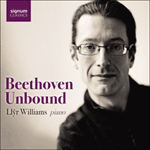The Sonata in G major, Op 49 No 2, is even simpler. It was most probably composed for a member of the aristocracy during Beethoven’s visit to Prague in 1796, when he also wrote the concert aria
Ah! perfido. The dedicatee must have received the autograph because only a sketchy draft remains—one with few dynamics. This doesn’t mean that you shouldn’t add them. In fact this sonata can act as a very useful study in this regard. After a straightforward, no-fuss Allegro, ma non troppo (a study for playing triplets), Beethoven gives us a beautiful movement in the tempo of a minuet, an example of a dance that figured prominently in his music. He must have liked this theme because he used it again in the third movement of his Septet, Op 20 (1799). There is some debate about whether or not the left hand should be played detached. It is interesting to see that in the septet version, Beethoven clearly writes the quaver accompaniment, first played by the viola and then by the cello, staccato.
from notes by Angela Hewitt © 2016
La Sonate en sol majeur, op.49 nº 2, est encore plus simple. Elle fut sans doute composée pour un membre de l’aristocratie au cours de la visite de Beethoven à Prague en 1796, où il composa aussi l’air de concert
Ah! perfido. Le dédicataire dut recevoir la partition autographe car il ne reste qu’un brouillon esquissé—avec peu d’indications de nuances, ce qui ne veut pas dire qu’il ne faut pas en ajouter. En fait, cette sonate peut servir d’étude très utile à cet égard. Après un Allegro, ma non troppo simple et sans histoire (une étude pour jouer des triolets), Beethoven nous donne un magnifique mouvement dans un tempo de menuet, un type de danse qui joua un rôle important dans sa musique. Il doit avoir aimé ce thème car il le réutilisa dans le troisième mouvement de son Septuor, op.20 (1799). La façon dont on doit jouer la main gauche donne lieu à discussion: détachée ou non. Il est intéressant de voir que, dans la version pour septuor, Beethoven écrit clairement staccato l’accompagnement en croches, tout d’abord joué à l’alto, puis au violoncelle.
extrait des notes rédigées par Angela Hewitt © 2016
Français: Marie-Stella Pâris
Die Sonate in G-Dur, op. 49 Nr. 2, ist noch schlichter gehalten. Sie entstand wahrscheinlich für eine(n) adelige(n) Musiker(in), als Beethoven sich 1796 in Prag aufhielt; zur gleichen Zeit komponierte er auch die Konzertarie
Ah! perfido. Der oder die Widmungsträger(in) muss das Manuskript erhalten haben, da uns heute nur eine bruchstückhafte Skizze überliefert ist, die kaum Hinweise zur Dynamik enthält. Das bedeutet allerdings nicht, dass diese nicht hinzugefügt werden sollte. Im Gegenteil ist es sogar sehr lohnenswert, die Sonate in dieser Hinsicht genauer zu untersuchen. Nach einem unkomplizierten, freimütigen Allegro, ma non troppo (ein Übungsstück für Triolen) wartet Beethoven mit einem wunderschönen Satz im Tempo eines Menuetts auf—ein Beispiel für einen Tanz, der häufig in seiner Musik vorkam. Er muss dieses Thema besonders gemocht haben, da es in dem dritten Satz seines Septetts op. 20 (1799) noch einmal vorkommt. Es herrscht Uneinigkeit darüber, ob die linke Hand abgesetzt gespielt werden sollte oder nicht—es ist interessant, dass Beethoven die Achtel-Begleitung in der Version für Septett (zunächst in der Viola, dann im Cello) im Staccato setzt.
aus dem Begleittext von Angela Hewitt © 2016
Deutsch: Viola Scheffel


 PERFORMANCE
PERFORMANCE RECORDING
RECORDING


 Beethoven: Beethoven Unbound
Beethoven: Beethoven Unbound
